
The most popular Mahavihara of the ancient times, a significant Buddhist seat of academic excellence and a modest pilgrim center, all wrapped in a wisp of spirituality, Nalanda continues to be an equally enriching location in the present. It offers vibrant substance of spirituality, history, culture, architecture, and tourism. This city houses one of the world’s oldest and finest residential universities which itself was an architectural masterpiece. Although in ruins, the entire complex presents a pretty picture and is flocked by tourists day in and day out. It has “viharas” or monasteries to the east and “chaiyas” or temples to the west. In addition to this, the complex houses a charming little museum, which has a collection of several of original Buddhist stupas, Hindu and Buddhist bronzes, coins, terracotta jars, a sample of burnt rice etc. The district is believed to be a cradle of religions. Apart from Buddhism, it is an important center for Jainism, Hinduism, and Sufism as well. Considering the rich heritage and the historical importance, it is a hot tourist destination.
Nalanda University
Nalanda University is a UNESCO world heritage site is located South Bihar. Considered as one of the oldest universities in the world and known as Nalanda Mahavira back in time, its origins date back to the 3rd century. Mahavira is a Sanskrit term for a great ‘Vihara'(Buddhist Monastery). Located about 85 km away from Patna, it is regarded as one of the greatest and oldest universities recorded in history. It finds references in the oldest epics of India as well as in the travels of Hiuen Tsang. The Gupta kings built various monasteries in old Kusan style of architecture. Emperor Ashoka and Emperor Harshavandhana were also patrons of this university who built few temples, viharas, and monasteries for the university. Former President Dr. APJ Abdul Kalam pitched the idea of reviving the university in March 2016. With reference found in the Tibetan and Chinese culture, the university was a centre of advanced Vedic learnings until it was ransacked by Bakhtiyar Khilji in the 12th century. Lord Buddha visited Nalanda several times during his lifetime, but the university became popular in the later years when Hieun Tsang stayed here in the 7th century AD and he left a detailed description of the education system and monastic life of this place. The site was recovered by Archeological Survey of India in 1915. It’s said that the library of the university had so many books and manuscripts that it kept on burning for six months after the entire structure went up in flames.
The Great Stupa
Present amongst the ruins of the Nalanda University, this Stupa was built in the 3rd century by Ashoka in the honour of Sariputra. After the seven accretions to it, this structure is shaped like a pyramid and is flanked by flights of steps and splendid sculptures as well.
Hiuen Tsang Memorial Hall
The Hiuen Tsang Memorial Hall was built in memory of the Chinese scholar in the location where he was said to have resided for over 12 years during his time in the country. The memorial hall is home to writings of the scholar about his observations regarding medieval India, which forms the basis of much of the knowledge of that time.
Pawapuri
Pawapuri is a holy site for the Jains. It is situated in the Nalanda district of Bihar state in Eastern India. A long time ago, Pawapuri was the twin capital of Mall Mahajanpad. Mahajanpad later became a part of the kingdom of Magadha and Ajatshatru was a devotee of Lord Mahavira. During the rule of Ajatshatru, the king of Pawapuri was known as Hastipal. When in Pawapuri, Mahavira stayed in the Rajikshala of the king. It is considered as a sacred place because Lord Mahavira was buried here in 500 BC.
Nalanda Archaeological Museum
Housing the ancient relics of Nalanda University, this museum offers a glance into the culture of ancient Nalanda. Pala Art is displayed through the assorted artifacts maintained here.The statues here are mainly engraved on basalt stone, but others made out of stucco, bronze, stone and terracotta are also present.
Kundalpur
Located just outside Nalanda, Kundalpur is the place which is believed to be the birthplace of Lord Mahavira, the 24th and last of Jain Tirthankaras. It is also the place of birth of Gautam Swamiji who was the first disciple of Lord Mahavira.A grand temple with beautiful spires has been built here to mark the birthplace with a four and half feet tall idol of Bhagwan Mahavira Padmasana. Within the complex, there is a serene Trikal Chaubeesi Jinmandir where there are 72 idols of Tirthankaras, representing 24 each of the past, present and the future age.





Hey there! I’m at work surfing around your blog from my new apple iphone! Just wanted to say I love reading your blog and look forward to all your posts! Carry on the great work!
Simply desire to say your article is as surprising. The clearness in your put up is simply excellent and i could suppose you’re an expert in this subject. Well along with your permission let me to snatch your feed to keep up to date with drawing close post. Thanks one million and please carry on the gratifying work.
There is clearly a lot to know about this. I assume you made some good points in features also.
It’s a pity you don’t have a donate button! I’d without a doubt donate to this fantastic blog! I suppose for now i’ll settle for bookmarking and adding your RSS feed to my Google account. I look forward to fresh updates and will share this website with my Facebook group. Talk soon!
What i don’t understood is actually how you’re not actually much more well-liked than you may be now. You’re very intelligent. You realize therefore considerably relating to this subject, made me personally consider it from numerous varied angles. Its like men and women aren’t fascinated unless it’s one thing to do with Lady gaga! Your own stuffs excellent. Always maintain it up!
I’m not sure exactly why but this web site is loading very slow for me. Is anyone else having this issue or is it a problem on my end? I’ll check back later and see if the problem still exists.
There is noticeably a bundle to find out about this. I assume you made certain nice factors in options also.
Throughout this grand design of things you receive an A+ with regard to effort and hard work. Where you misplaced me personally was first on your particulars. You know, as the maxim goes, details make or break the argument.. And it couldn’t be more accurate here. Having said that, allow me tell you precisely what did work. Your authoring is actually pretty powerful and that is probably the reason why I am making an effort in order to opine. I do not make it a regular habit of doing that. Secondly, while I can notice the jumps in logic you make, I am not necessarily sure of how you appear to connect your ideas which produce the final result. For now I will, no doubt subscribe to your point however hope in the future you actually connect the facts better.
Wohh precisely what I was looking for, thanks for putting up.
I’m still learning from you, but I’m making my way to the top as well. I certainly enjoy reading everything that is written on your website.Keep the posts coming. I loved it!
With havin so much written content do you ever run into any issues of plagorism or copyright violation? My site has a lot of completely unique content I’ve either authored myself or outsourced but it seems a lot of it is popping it up all over the web without my authorization. Do you know any ways to help stop content from being ripped off? I’d certainly appreciate it.
Real instructive and wonderful structure of subject matter, now that’s user genial (:.
I was recommended this blog by means of my cousin. I’m no longer positive whether or not this put up is written by means of him as no one else realize such distinctive about my difficulty. You’re incredible! Thank you!
Hi, Neat post. There’s a problem along with your site in web explorer, might test this?K IE nonetheless is the marketplace leader and a big section of folks will leave out your wonderful writing because of this problem.
Appreciate it for helping out, excellent info. “The surest way to be deceived is to think oneself cleverer than the others.” by La Rochefoucauld.
I discovered your blog site on google and check a few of your early posts. Continue to keep up the very good operate. I just additional up your RSS feed to my MSN News Reader. Seeking forward to reading more from you later on!…
Good website! I truly love how it is simple on my eyes and the data are well written. I’m wondering how I might be notified when a new post has been made. I’ve subscribed to your feed which must do the trick! Have a nice day!
certainly like your web-site but you have to test the spelling on several of your posts. Several of them are rife with spelling issues and I to find it very troublesome to tell the reality on the other hand I’ll certainly come again again.
Hello, Neat post. There is an issue with your website in internet explorer, could check this… IE still is the market leader and a big component to other folks will omit your great writing due to this problem.
Wow! This blog looks just like my old one! It’s on a completely different topic but it has pretty much the same page layout and design. Excellent choice of colors!
Great site you have here but I was curious about if you knew of any user discussion forums that cover the same topics talked about here? I’d really love to be a part of online community where I can get opinions from other knowledgeable people that share the same interest. If you have any recommendations, please let me know. Bless you!
I conceive this internet site has very excellent pent subject material content.
You have noted very interesting details! ps nice web site.
I do not even know the way I finished up here, but I thought this post was good. I don’t know who you’re however certainly you are going to a well-known blogger should you aren’t already ;) Cheers!
Really informative and good body structure of subject matter, now that’s user genial (:.
I’ve been absent for some time, but now I remember why I used to love this blog. Thank you, I will try and check back more often. How frequently you update your website?
I beloved as much as you will obtain performed right here. The sketch is tasteful, your authored subject matter stylish. nonetheless, you command get bought an impatience over that you would like be turning in the following. sick without a doubt come further before again as exactly the similar just about very continuously inside of case you protect this increase.
Just a smiling visitor here to share the love (:, btw great design and style.
Hi there, You’ve performed an excellent job. I’ll definitely digg it and personally suggest to my friends. I’m confident they will be benefited from this web site.
Thank you for sharing excellent informations. Your web site is so cool. I am impressed by the details that you?¦ve on this site. It reveals how nicely you understand this subject. Bookmarked this web page, will come back for extra articles. You, my friend, ROCK! I found just the info I already searched everywhere and just couldn’t come across. What a great site.